SpringCloud系列——TX-LCN分布式事务管理
前言
SpringCloud分布式架构给我们带来开发上的便利,同时增加了我们对事务管理的难度,微服务的遍地开花,本地事务已经无法满足分布式的要求,由此分布式事务问题诞生。 分布式事务被称为世界性的难题。
更多分布式事务介绍请看这篇文章:再有人问你分布式事务,把这篇扔给他
本文记录整合TX-LCN分布式事务框架管理分布式事务,用的版本是5.0.2.RELEASE
TX-LCN
简单介绍
TX-LCN分布式事务框架,LCN并不生产事务,LCN只是本地事务的协调工,LCN是一个高性能的分布式事务框架,兼容dubbo、springcloud框架,支持RPC框架拓展,支持各种ORM框架、NoSQL、负载均衡、事务补偿
特性一览
1、一致性,通过TxManager协调控制与事务补偿机制确保数据一致性
2、易用性,仅需要在业务方法上添加@TxTransaction注解即可
3、高可用,项目模块不仅可高可用部署,事务协调器也可集群化部署
4、扩展性,支持各种RPC框架扩展,支持通讯协议与事务模式扩展
更多介绍跟文档说明请看官网:https://www.txlcn.org/zh-cn/index.html
撸代码
我们按照官方文档(https://www.txlcn.org/zh-cn/docs/preface.html)一步步操作:
Tx-Manager
创建数据库、表
-
创建MySQL数据库, 名称为:tx-manager(我们直接选择在我们自己的数据库下面创建表就行了,这里就不创建这个数据库)
-
创建数据表:t_tx_exception
CREATE TABLE `t_tx_exception` ( `id` bigint(20) NOT NULL AUTO_INCREMENT, `group_id` varchar(64) CHARACTER SET utf8mb4 COLLATE utf8mb4_general_ci NULL DEFAULT NULL, `unit_id` varchar(32) CHARACTER SET utf8mb4 COLLATE utf8mb4_general_ci NULL DEFAULT NULL, `mod_id` varchar(128) CHARACTER SET utf8mb4 COLLATE utf8mb4_general_ci NULL DEFAULT NULL, `transaction_state` tinyint(4) NULL DEFAULT NULL, `registrar` tinyint(4) NULL DEFAULT NULL, `remark` varchar(4096) NULL DEFAULT NULL, `ex_state` tinyint(4) NULL DEFAULT NULL COMMENT '0 未解决 1已解决', `create_time` datetime NULL DEFAULT NULL, PRIMARY KEY (`id`) USING BTREE ) ENGINE = InnoDB AUTO_INCREMENT = 1 CHARACTER SET = utf8mb4 COLLATE = utf8mb4_general_ci ROW_FORMAT = Dynamic;
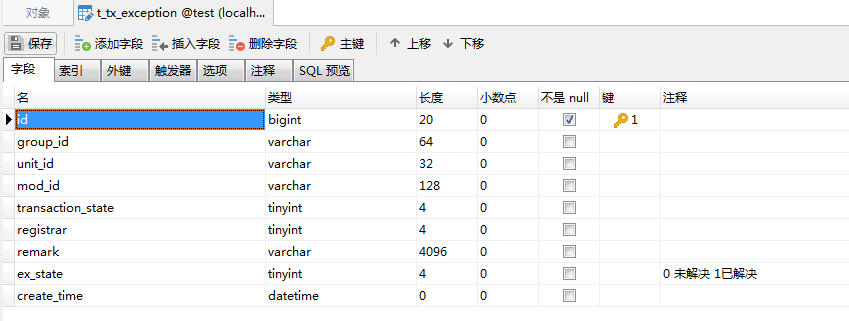
下载官网提供的最新版的TM项目,修改配置文件(PS:由于官网的下载地址打不开,我们去GitHub上面下载例子:https://github.com/codingapi/txlcn-demo),参考txlcn-demo-tm工程,在我们之前的项目下面创建一个springboot项目叫txlcn-tm
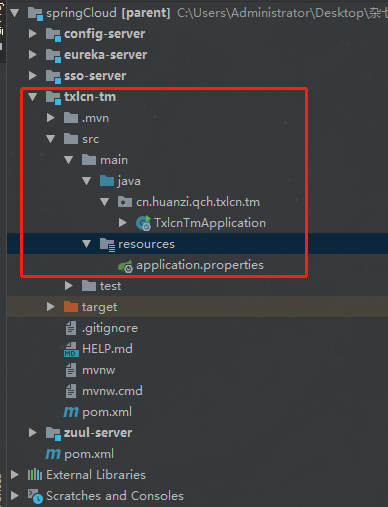
创建好springboot项目后,参照例子修改pom.xml文件
<?xml version="1.0" encoding="UTF-8"?> <project xmlns="http://maven.apache.org/POM/4.0.0" xmlns:xsi="http://www.w3.org/2001/XMLSchema-instance" xsi:schemaLocation="http://maven.apache.org/POM/4.0.0 http://maven.apache.org/xsd/maven-4.0.0.xsd"> <modelVersion>4.0.0</modelVersion> <groupId>cn.huanzi.qch.txlcn</groupId> <artifactId>txlcn-tm</artifactId> <version>0.0.1-SNAPSHOT</version> <name>txlcn-tm</name> <description>Tx-Manager(TM),TX-LCN分布式事务框架的独立服务</description> <!--继承信息--> <parent> <groupId>cn.huanzi.qch</groupId> <artifactId>parent</artifactId> <version>1.0.0</version> </parent> <dependencies> <!-- 参照例子引入需要的依赖jar --> <dependency> <groupId>com.codingapi.txlcn</groupId> <artifactId>txlcn-tm</artifactId> <version>5.0.2.RELEASE</version> </dependency> <!-- text报错,添加一下依赖--> <dependency> <groupId>org.springframework.boot</groupId> <artifactId>spring-boot-starter-test</artifactId> <scope>test</scope> </dependency> </dependencies> <!-- 构建工具 --> <build> <plugins> <plugin> <groupId>org.springframework.boot</groupId> <artifactId>spring-boot-maven-plugin</artifactId> </plugin> </plugins> <finalName>txlcn-tm</finalName> </build> </project>
参照官网修改配置文件,详细的TM配置请戳:https://www.txlcn.org/zh-cn/docs/setting/manager.html,开发阶段最好开启日志,并设置为debug等级,这样方便追踪排查问题
spring.application.name=txlcn-tm server.port=7970 spring.datasource.driver-class-name=com.mysql.jdbc.Driver spring.datasource.url=jdbc:mysql://localhost:3306/test?characterEncoding=UTF-8&serverTimezone=Asia/Shanghai spring.datasource.username=root spring.datasource.password=123456 spring.jpa.database-platform=org.hibernate.dialect.MySQL5InnoDBDialect spring.jpa.hibernate.ddl-auto=validate # TM后台登陆密码 tx-lcn.manager.admin-key=123456 tx-lcn.manager.host=127.0.0.1 tx-lcn.manager.port=8070 # 开启日志,默认为false tx-lcn.logger.enabled=true tx-lcn.logger.driver-class-name=${spring.datasource.driver-class-name} tx-lcn.logger.jdbc-url=${spring.datasource.url} tx-lcn.logger.username=${spring.datasource.username} tx-lcn.logger.password=${spring.datasource.password}
logging.level.com.codingapi.txlcn=DEBUG #redis 主机 spring.redis.host=127.0.0.1 #redis 端口 spring.redis.port=6379 #redis 密码 spring.redis.password=
在启动类添加注解 @EnableTransactionManagerServer
package cn.huanzi.qch.txlcn.tm; import com.codingapi.txlcn.tm.config.EnableTransactionManagerServer; import org.springframework.boot.SpringApplication; import org.springframework.boot.autoconfigure.SpringBootApplication; @SpringBootApplication @EnableTransactionManagerServer public class TxlcnTmApplication { public static void main(String[] args) { SpringApplication.run(TxlcnTmApplication.class, args); } }
把我们的Redis服务运行起来,然后启动txlcn-tm,启动成功后访问tm后台管理系统,使用默认密码登录(可以配置登录密码),访问 http://127.0.0.1:7970/admin/index.html进入管理后台,默认密码是codingapi,我们这里配置了123456

启动TM之前记得先启动我们的Redis服务,到这里,我们的tm搭建成功,更多TM介绍,请看官网TM管理手册:https://www.txlcn.org/zh-cn/docs/manageradmin.html
Tx-Client
TC端参照官网一步步操作:https://www.txlcn.org/zh-cn/docs/start.html
1、TC引入依赖
<dependency> <groupId>com.codingapi.txlcn</groupId> <artifactId>txlcn-tc</artifactId> <version>5.0.2.RELEASE</version> </dependency> <dependency> <groupId>com.codingapi.txlcn</groupId> <artifactId>txlcn-txmsg-netty</artifactId> <version>5.0.2.RELEASE</version> </dependency>
PS:如果你没有添加jdbc驱动,启动的时候会报错
Parameter 0 of constructor in com.codingapi.txlcn.tc.core.transaction.txc.analy.TableStructAnalyser required a bean of type 'javax.sql.DataSource' that could not be found.
因此要添加jdbc依赖
<dependency> <groupId>org.springframework.boot</groupId> <artifactId>spring-boot-starter-jdbc</artifactId> </dependency>
2、配置文件添加TM地址跟监听端口,如果TM是默认8070端口,且跟TC部署在同一台机器,可以忽略这个配置,并且开启日志,开发阶段最好开启日志,并设置为debug等级,这样方便追踪排查问题
# 是否启动LCN负载均衡策略(优化选项,开启与否,功能不受影响)
tx-lcn.ribbon.loadbalancer.dtx.enabled=true
# 默认之配置为TM的本机默认端口
tx-lcn.client.manager-address=127.0.0.1:8070
# 开启日志,默认为false
tx-lcn.logger.enabled=true
tx-lcn.logger.driver-class-name=${spring.datasource.driver-class-name}
tx-lcn.logger.jdbc-url=${spring.datasource.url}
tx-lcn.logger.username=${spring.datasource.username}
tx-lcn.logger.password=${spring.datasource.password}
logging.level.com.codingapi.txlcn=DEBUG
3、在启动类上使用 @EnableDistributedTransaction
//省略其他代码... @EnableDistributedTransaction public class MyspringbootApplication { public static void main(String[] args) { SpringApplication.run(MyspringbootApplication.class, args); } }
4、在提交本地事务的地方添加@Target({ElementType.METHOD})
测试代码
我们挑选之前的两个项目myspringboot、springdatejpa,按照步骤设置成TC,
并且在两个TC添加测试接口,
myspringboot
controller
/** * 测试分布式事务 */ @GetMapping("feign/save") Result<UserVo> save(UserVo userVo){ //模拟数据 Description description = new Description(); description.setUserId("111"); description.setDescription("测试用户描述"); Result<Description> save = descriptionService.save(description); System.out.println(save); return null; }
service
@Override @LcnTransaction//分布式事务 @Transactional //本地事务 public Result<Description> save(Description description) { UserVo userVo = new UserVo(); userVo.setUsername("huanzi"); userVo.setPassword("123"); //调用springdatejpa服务保存userVo Result<UserVo> result = myspringbootFeign.save(userVo); System.out.println(result); //myspringboot本地服务保存description Description save = descriptionRepository.save(description); System.out.println(save); //模拟发生异常 throw new RuntimeException("business code error"); }
feign
@FeignClient(name = "springdatejpa", path = "/user/",fallback = MyspringbootFeignFallback.class,fallbackFactory = MyspringbootFeignFallbackFactory.class) public interface MyspringbootFeign { @RequestMapping(value = "save") Result<UserVo> save(@RequestBody UserVo userVo); }
springdatejpa
这个原先就已经有对应的save接口,其他的代码我们就不贴了,在UserServiceImpl类重写save方法,在save方法上添加@LcnTransaction注解
@LcnTransaction//分布式事务 @Transactional //本地事务 @Override public Result<UserVo> save(UserVo entity) { User user = userRepository.save(FastCopy.copy(entity, User.class)); return Result.of(FastCopy.copy(user, UserVo.class)); }
演示效果
启动所有项目,TM跟Redis服务也要记得启动

查看TM后台,可以看到成功注册了两个TC
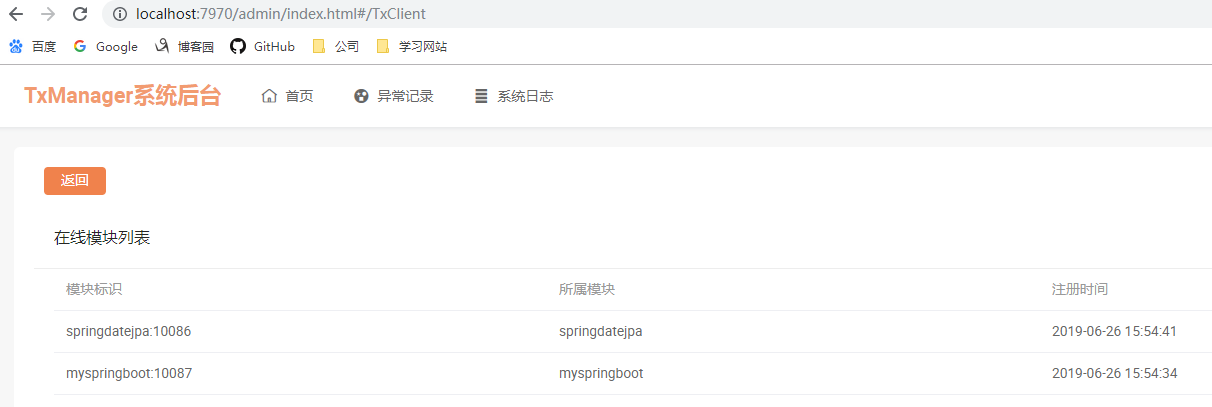
访问http://localhost:10010/myspringboot/feign/save,被单点登录拦截,登录后跳转正常跳转该接口,这些就不再演示了,下面直接看后台debug日志
调用流程
myspringboot(A) ---> springdatejpa(B)
事务回滚
myspringboot(A)

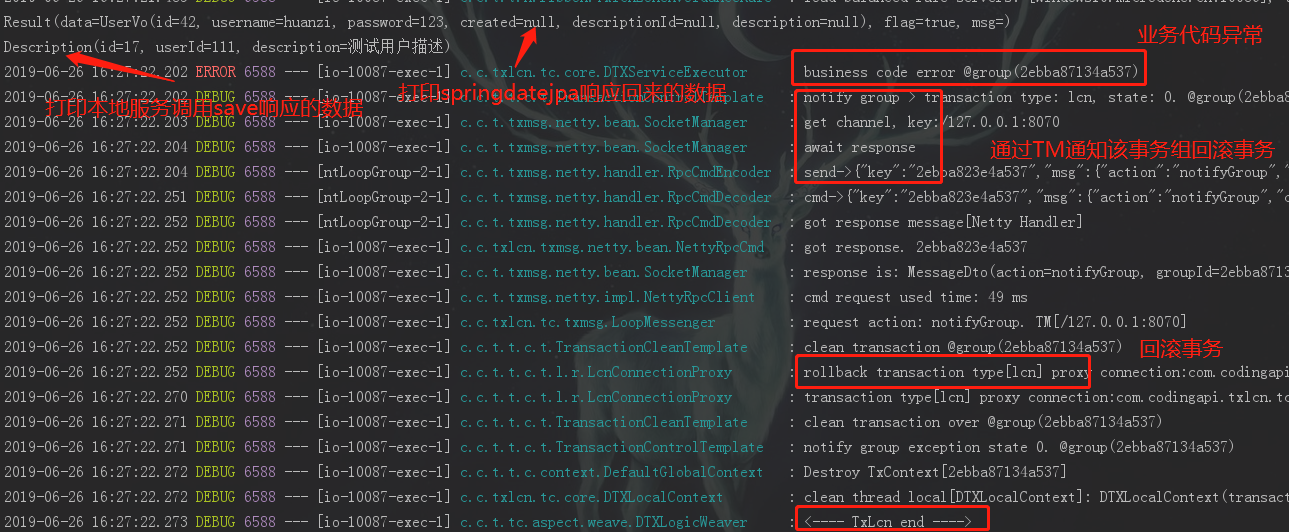
springdatejpa(B)
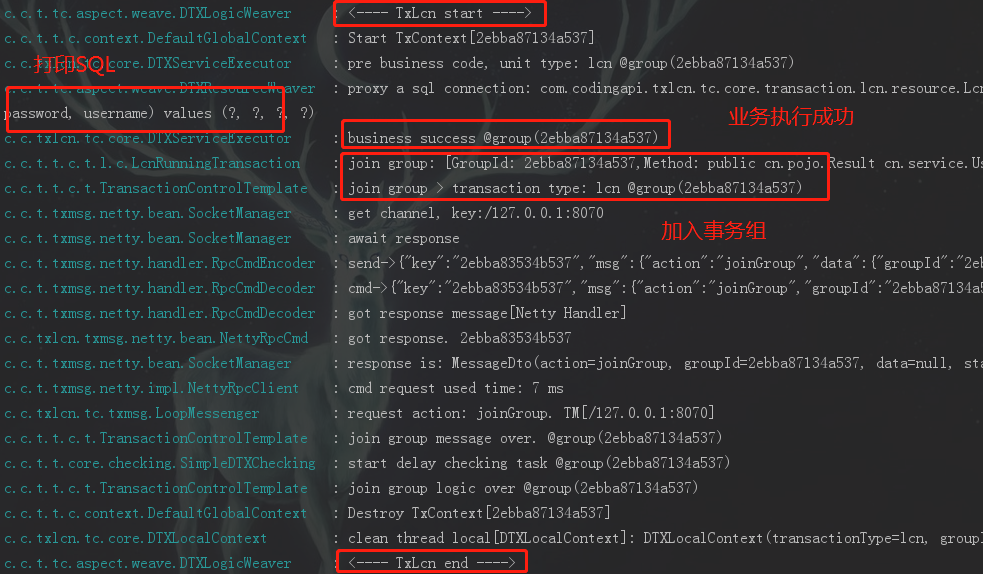
到这里springdatejpa(B)已经响应了user数据给myspringboot(A),而后收到回滚通知

事务提交
我们看一下事务正常提交是怎么样的,我们把模拟异常注释起来,并返回保存后的数据
//模拟发生异常 //throw new RuntimeException("business code error"); return Result.of(save);
我们直接从springdatejpa(B)响应数据之后看
myspringboot(A)
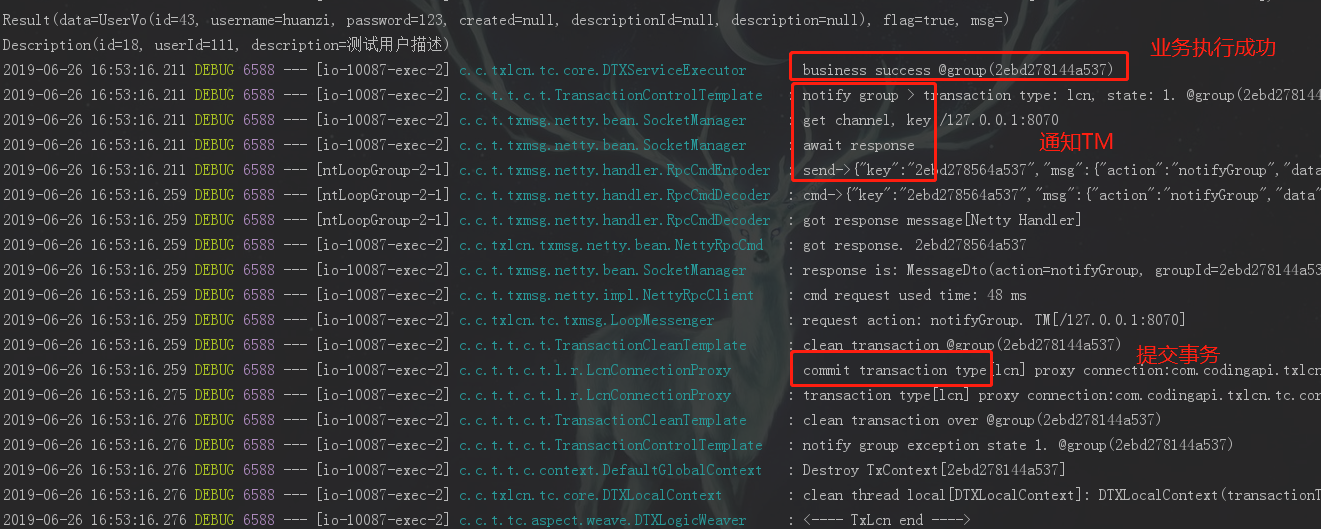
springdatejpa(B)
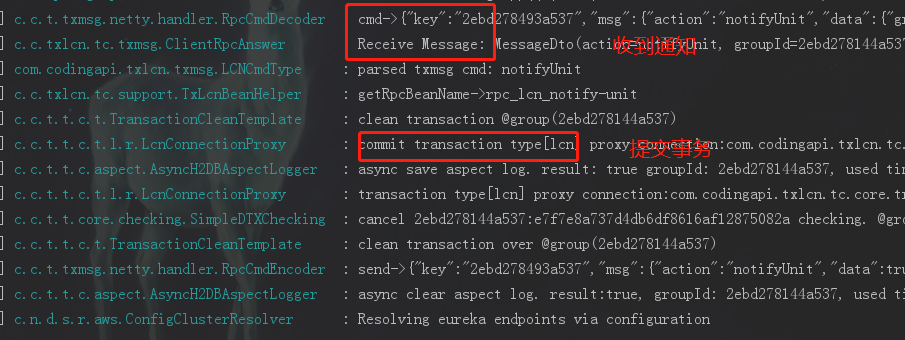
具体的流程已经事务控制原理可以查看官网:https://www.txlcn.org/zh-cn/docs/principle/control.html,这里简单的贴出官网提供的原理图:
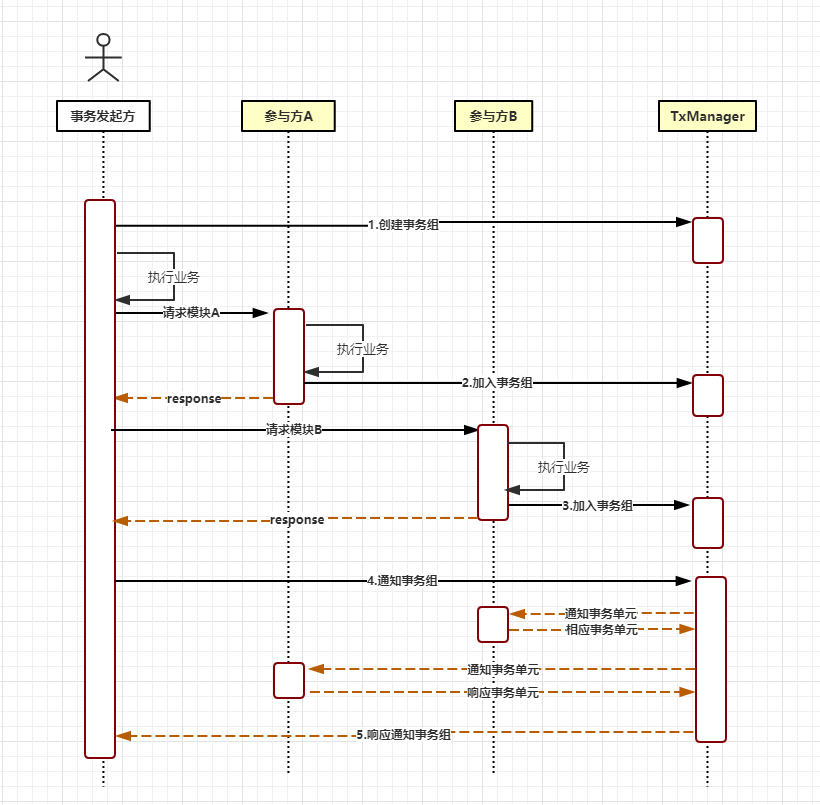
后记
要注意我们的springboot版本跟txlcn的版本是不是兼容,按照官网的快速开始(https://www.txlcn.org/zh-cn/docs/start.html),以及参考官方例子(https://github.com/codingapi/txlcn-demo),一路下来碰到了一下小问题在这里总结一下:
1、A调B,A抛出异常,A事务回滚,B事务没有回滚
原因:这个是因为刚开始我是在A的controller层调用B,相当于B是一个单独是事务组,A又是一个单独的事务组
解决:在A开启事务后再调用B
代码开源
代码已经开源、托管到我的GitHub、码云:
GitHub:https://github.com/huanzi-qch/springCloud
码云:https://gitee.com/huanzi-qch/springCloud
版权声明
捐献、打赏

支付宝

微信
交流群




